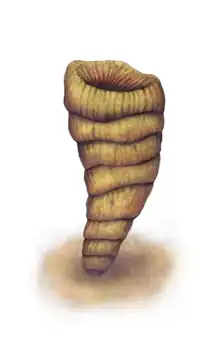Capsospongia
Capsospongia, formerly known as Corralia or Corralio, is a middle Cambrian sponge genus known from 3 specimens in the Burgess shale.[1] Its type and only species is Capsospongia undulata. It has a narrow base, and consists of bulging rings which get wider further up the sponge, resulting in a conical shape. Its open top was presumably used to expel water that had passed through the sponge cells and been filtered for nutrients.
| Capsospongia Temporal range: Middle Cambrian, | |
|---|---|
 | |
| Artist's restoration | |
| Scientific classification | |
| Domain: | Eukaryota |
| Kingdom: | Animalia |
| Phylum: | Porifera |
| Class: | Demospongiae |
| Family: | †Anthaspidellidae |
| Genus: | †Capsospongia Rigby 1986 |
| Species: | †C. undulata |
| Binomial name | |
| †Capsospongia undulata Walcott 1920 | |
Like most sponges, Capsospoingia had a spicular skeleton; long spicules parallel to the growth direction formed columns which were connected by shorter lateral spicules.
History
Capsospongia undulata was named in 1920 by Charles Walcott as Corralia undulata.[2] However, the name was preoccupied by Corralia Roewer, 1913, a member of Opiliones. In 1955, de Laubenfels renamed the genus Corralio, adopting an incorrect spelling of Corralia Walcott had used.[3][4] In 1986 Keith Rigby established the new genus Capsospongia for it.[5] In 2004, he and Desmond Collins described a third specimen.[5]
C. undulata intersects with the complicated taxonomic history of the anomalocarids. In 1911, Walcott had named two taxa, Peytoia and Laggania, which he interpreted as a jellyfish and a sea cucumber respectively.[6] In 1978, Simon Conway Morris recognized that the mouthparts of Laggania closely resembled Peytoia, but erroneously concluded that this was because Laggania was a composite fossil of a Peytoia and another organism, which he concluded was a sponge and suggested was probably a specimen of C. undulata.[4] However, it was subsequently determined that Laggania and Peytoia were partial specimens of a larger animal, a radiodont, which now bears the name Peytoia.[7][8]
References
- Briggs, D. E. G.; Erwin, D. H.; Collier, F. J. (1995), Fossils of the Burgess Shale, Washington: Smithsonian Inst Press, ISBN 1-56098-659-X, OCLC 231793738
- Walcott, Charles D. (1920). "Middle Cambrian Spongiae". Smithsonian Miscellaneous Collections. 67 (6).
- de Laubenfels, M. W. (1955). "Porifera". In Moore, Raymond C. (ed.). Treatise on Invertebrate Paleontology Part E: Archaeocyatha and Porifera.
- Conway Morris, S. (1978). "Laggania cambria Walcott: A Composite Fossil". Journal of Paleontology. 52 (1): 126–131. JSTOR 1303799.
- "Capsospongia undulata". Burgess Shale Fossil Gallery. Royal Ontario Museum. Retrieved 2020-08-10.
- Walcott, Charles D. (1911-04-08). "Middle Cambrian holothurians and medusae". Smithsonian Miscellaneous Collections. 57 (3).
- Collins, Desmond (1996). "The "Evolution" of Anomalocaris and Its Classification in the Arthropod Class Dinocarida (nov.) and Order Radiodonta (nov.)". Journal of Paleontology. 70 (2): 280–293. doi:10.1017/S0022336000023362. JSTOR 1306391. S2CID 131622496.
- Daley, Allison C.; Bergström, Jan (2012). "The oral cone of Anomalocaris is not a classic peytoia". Naturwissenschaften. 99 (6): 501–504. doi:10.1007/s00114-012-0910-8. PMID 22476406. S2CID 253633303.
External links
- "Capsospongia undulata". Burgess Shale Fossil Gallery. Virtual Museum of Canada. 2011. Archived from the original on 2020-11-12.